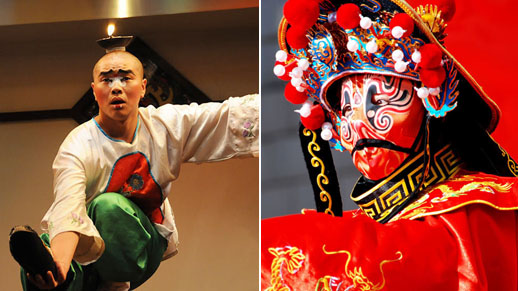The ancient Sichuan Opera
 0 Comment(s)
0 Comment(s) Print
Print E-mail China.org.cn, January 9, 2015
E-mail China.org.cn, January 9, 2015
Editor's note: Sichuan Opera is a major type of Chinese opera. The government attaches great importance to protecting it, and it was one of the first cultural treasures inscribed in the State Council-approved National Intangible Cultural Heritage list.
Historical Sichuan Opera consists of many excellent traditional plays that feature rich percussion and refined acting. It is a very popular folk art in Sichuan, Yunnan and Guizhou provinces in southwest China. Sichuan Opera encompasses four characteristic melodic styles -- Gaoqiang, Kunqiang, Huqinqiang and Ruoqiang, and local lantern theater. Except for lantern theater, all of these were introduced in Sichuan between the late Ming Dynasty (1368–1644) and the middle of the Qing Dynasty (1644-1911). In the earlier Tang Dynasty (618-907), it was said that Sichuan Opera was the "crown of the world."
Sichuan Opera expresses the character of Sichuan and particularly the character of Chengdu, the motherland of Sichuan Opera. The dialogue in Sichuan Opera is usually lively, humorous, and full of pronounced local flavor. There are hundreds of different plays written for Sichuan Opera, many of which incorporate the "face changing," "fire spitting" and "cascading silk sleeves" stunts that are unique to the genre.
![Sichuan Opera is a major type of Chinese opera. 'Face changing' is a unique stunt incorporated in Sichuan Opera that is used to express the changing emotions of characters. [Photo/China.org.cn] Sichuan Opera is a major type of Chinese opera. 'Face changing' is a unique stunt incorporated in Sichuan Opera that is used to express the changing emotions of characters. [Photo/China.org.cn]](http://images.china.cn/attachement/jpg/site1007/20150109/00016c42b36b1619733b1f.jpg) |
|
Sichuan Opera is a major type of Chinese opera. "Face changing" is a unique stunt incorporated in Sichuan Opera that is used to express the changing emotions of characters. [Photo/China.org.cn] |





Go to Forum >>0 Comment(s)